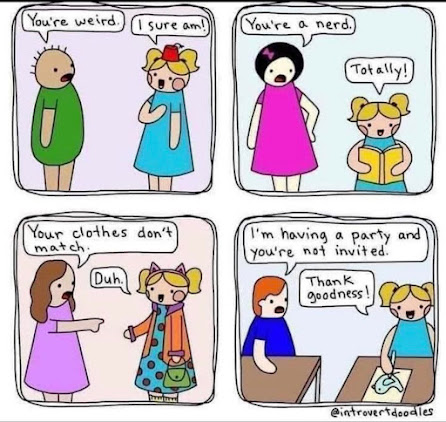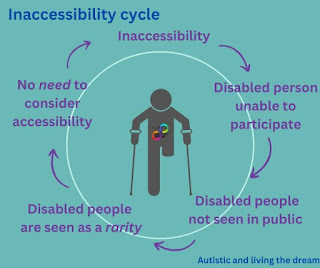This image comes from a century ago, of course. It's still very hard to be different, but sometimes it's vital.
When I taught a course called the Challenge of Change, I offered up a number of challenges along the way. Students who were uncomfortable participating in any of them were allowed the alternative option of writing a brief paragraph explaining their reluctance. Some took that option, but most participated.
The first challenge came with our discussion of the differences between Functionalism and Conflict Theory perspectives, one leaning towards maintaining the status quo to avoid anomie which can lead to an increase in suicides; the other critiquing that theory as a way to perpetuate a system that benefits those at the top of the status hierarchy. We brainstorm current norms that are beneficial, neutral, or harmful. That list always included some still-too-rigid gender binary norms including, "Guys have to pay for dinner." Then I ask them to break a norm that doesn't benefit anyone in any way, maybe one that actually harms us or holds us back from being our most authentic selves!
The why: Often it's perfectly fine to blindly follow social norms, but sometimes, every once in a while, it can permit atrocities to happen: from cruel conspiracies against that one person in your friend group that's a little different to genocidal actions to nuclear war! So it's absolutely vital to be able to think about the norms we follow and, from time to time, to break the less useful ones just to make sure we still can. We need to practice non-conformity to make sure we can do it if we need to, and it's always wise to take a minute to think, "Do I really agree with this?" before acting.
I've been basically practicing for this my whole life in an army jacket and hippie dresses. So is anyone punk or with purple hair, etc. Although the challenge is to do something out of the ordinary for you, which might mean the goth kids shows up with very mainstream hair for a day.
And then we look at some experiments to show how easily we fall into line as a group. After WWII, researchers were very curious about what could possibly compel regular people to participate in the rounding up and gassing of millions of people. Hitler couldn't have done all that on his own, but he was able to sway the masses. We need to be aware of this stark reality to ensure we, ourselves, don't end up agreeing to enact atrocities.
In 1951 Solomon Asch had one participant and a group of confederates (who are in on it) state which is the longest line in a series. But for a few questions, the confederates all said the same wrong line to see what the participant would do. Almost 40% would also say the wrong line! When the majority does something, even if it's obviously wrong, it tends to make us question ourselves, and following along can help us avoid the discomfort of making waves, especially just in a silly experiment. Check it out in this 4-minute video:
In 1961, Stanley Milgram did his famous obedience experiments to see if he could convince participants to shock someone to death! Two people entered a room and a rigged coin toss would always make a confederate (an actor) the test-taker and the participant the test-giver. The test-taker had to memorize a string of words and would get a shock after any error. The participant was instructed to increase the voltage of the shock with each mistake (but it didn't actually shock the confederate). Then at a specific point, the actor would mention his heart condition and later keel over. The experimenter would just say, repeatedly, "Please continue with the experiment." As you can imagine, it was distressing for the participant, yet 63% continued to shock the confederate to the maximum level. Here's a 10-minute video on this:
In 1963, Hannah Arendt's famous work, Eichmann in Jerusalem: A Report on the Banality of Evil came out. She was a Jewish German writer who escaped to the U.S. during WWII. She actually ended up in a prison camp, but there was a moment of confusion among the guards over whether German citizens should be in there. She told the other women this was their only chance to get out, but they didn't listen. She marched to the gate and demanded release as a German citizen. They opened the gates for her, and she had to walk for days to find safe passage out of the country. The women who stayed behind all died. After the war, during the war crime trial of Adolph Eichmann, the New Yorker paid her to go back to report on the trial. Her take on it was that Eichmann was just a regular person following the rules. That massively pissed people off! He had to be a monster. But she stood her ground, and turned the article into a book explaining how easily and successfully a bureaucracy can create a populace who will do anything if they're divorced from any sense of personal responsibility and eager to do a good job for the authority figures directly rewarding them. We have to pay attention to the types of bureaucratic institutions that are just following the rules - like education system that insist they everyone must be allowed to choose whether or not to make because public health says so, and a medical institution that says the same because the CMOH, who's in Ford's back pocket, says so! Everyone says someone else told them to stop masking - that's the thing about the circular nature of bureaucracies: it's rule by nobody.
Then, in 1968, right after MLK's death, Jane Elliott did her famous blue eye / brown eye experiment on her grade 3 students, giving one group arm bands based on something as innocuous as eye colour, and merely suggesting they were kind of dumb and not very clean as she moved their seats to the back of the classroom. That was enough for the other half of the kids to hate them and bully them. She undid their hatred by pointing out what she had done and how easily people slipped into seeing others as enemies with the smallest suggestion. Here's a whole Frontline episode on that one.
Finally in 1968, Latané and Darley (famous for writing about Kitty Genovese in 1964) ran the Smoke Filled Room experiment I mentioned back here in which experimenters make it appear there's a fire. If alone, a person will immediately find the researchers to let them know of the smoke. When there were confederates in the room who don't react, the participant won't react either. Essentially, we'd rather die that look weird. (Check out a video explaining the experiment here with behind-the-scenes details).
Social adhesion is vitally important to our survival, so it makes sense to follow the herd except when the herd is running off a cliff. Then we need to use our prefrontal cortex to think about the wisdom of their decisions. I was raised with parents who often asked, "If Suzy jumped off a cliff, would you do that too?" which is a great catch-all comeback for a variety of complaints from "I need a clock-radio because Suzy has one," to "I shouldn't have to wear boots in winter because nobody else wears them!" They were adamant that I think for myself, but I think that's rare.
BUT, in every case in these experiments, there were people who didn't blindly follow the crowd or the instructions and questioned them or just walked out. Social science experiments typically need about 68% of people to do something for it to be considered statistically significant, but in each of these, between 10 and 30% of people - sometimes over 60% - did something else.
In 1970, in the middle of the Cold War, Irving Janis called this blind allegiance, groupthink. He was concerned that the reactions some had in these types of experiments could be enough, in a group of people, to convince someone to push the button that could kill us all. He developed ways to inoculate ourselves from groupthink, such as always appointing a devil's advocate, voting privately on issues, and giving people time to think. If you're ever rushed into making a public decision, consider being the devil's advocate to make sure to point out any potential problems.
So I wear a mask in public, everywhere, even when I'm just out riding my bike far away from anyone else. It's not just about my own safety, but about refusing to get sucked into the mass movement towards this bizarre notion of "normalcy." It's good practice for me, and it can help others to know that they're not alone out there! Hitler went for the disabled before he went for the Jewish people, legalizing the execution of anyone not deemed "worthy of life," and right now anyone disabled is being told it's on them to keep themselves safe from a virus that could killed them. That's just wrong! It prevents people who are more susceptible from accessing public spaces, and one-way masking doesn't come close to protecting them the way two-way masking can.I also make my advocacy for 2SLGBTQIA+ issues known despite the growing numbers of haters. An elementary school teacher just had their Pride flagged burned down by intruders in California of all places.
Public outrage, humiliation, and burning symbols all directed at an identifiable group of people is how it starts. It's up to us to make sure it doesn't continue.




No comments:
Post a Comment